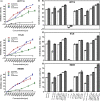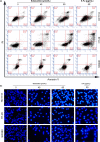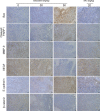Solasodine inhibits human colorectal cancer cells through suppression of the AKT/glycogen synthase kinase-3β/β-catenin pathway
- PMID: 28803443
- PMCID: PMC5666038
- DOI: 10.1111/cas.13354
Solasodine inhibits human colorectal cancer cells through suppression of the AKT/glycogen synthase kinase-3β/β-catenin pathway
Abstract
Solasodine is a main active component isolated from Solanum incanum L. that performs a wide range of functions containing anti-oxidant, anti-infection, and neurogenesis promotion. In this study, we explored the influence of solasodine on three types of human colorectal cancer (CRC) cell lines. The results show that solasodine prohibited CRC cell proliferation dose- and time-dependently and impeded CRC cell motility by downregulating MMPs. Solasodine was also found to fuel caspase-cascade reaction and increase the ratio between Bax and Bcl-2 so as to induce CRC cell apoptosis. When cells were pretreated with AKT activator (insulin-like growth factor-1) followed by solasodine, the solasodine-induced apoptosis was partially abrogated by insulin-like growth factor-1. Moreover, solasodine hindered tumor development and stimulated similar mechanisms in vivo. In general, our study provides the first evidence that solasodine has a suppressive effect on CRC cells and that this agent may be a novel therapeutic drug for CRC treatment.
Keywords: Apoptosis; colorectal cancer; metastasis; solasodine; β-Catenin.
© 2017 The Authors. Cancer Science published by John Wiley & Sons Australia, Ltd on behalf of Japanese Cancer Association.
Figures














Similar articles
-
A combined treatment with Ursolic acid and Solasodine inhibits colorectal cancer progression through the AKT1/ERK1/2-GSK-3β-β-catenin axis.Phytomedicine. 2024 Dec;135:156068. doi: 10.1016/j.phymed.2024.156068. Epub 2024 Sep 17. Phytomedicine. 2024. PMID: 39515101
-
Isobavachalcone isolated from Psoralea corylifolia inhibits cell proliferation and induces apoptosis via inhibiting the AKT/GSK-3β/β-catenin pathway in colorectal cancer cells.Drug Des Devel Ther. 2019 May 1;13:1449-1460. doi: 10.2147/DDDT.S192681. eCollection 2019. Drug Des Devel Ther. 2019. PMID: 31118579 Free PMC article.
-
Solasodine reverses stemness and epithelial-mesenchymal transition in human colorectal cancer.Biochem Biophys Res Commun. 2018 Oct 28;505(2):485-491. doi: 10.1016/j.bbrc.2018.09.094. Epub 2018 Sep 26. Biochem Biophys Res Commun. 2018. PMID: 30268504
-
Toosendanin inhibits growth and induces apoptosis in colorectal cancer cells through suppression of AKT/GSK-3β/β-catenin pathway.Int J Oncol. 2015 Nov;47(5):1767-74. doi: 10.3892/ijo.2015.3157. Epub 2015 Sep 11. Int J Oncol. 2015. PMID: 26398368
-
Solasodine, Isolated from Solanum sisymbriifolium Fruits, Has a Potent Anti-Tumor Activity Against Pancreatic Cancer.Drug Des Devel Ther. 2021 Apr 13;15:1509-1519. doi: 10.2147/DDDT.S266746. eCollection 2021. Drug Des Devel Ther. 2021. Retraction in: Drug Des Devel Ther. 2023 Dec 07;17:3685-3686. doi: 10.2147/DDDT.S453387. PMID: 33888977 Free PMC article. Retracted.
Cited by
-
Identifying promising GSK3β inhibitors for cancer management: a computational pipeline combining virtual screening and molecular dynamics simulations.Front Chem. 2023 May 22;11:1200490. doi: 10.3389/fchem.2023.1200490. eCollection 2023. Front Chem. 2023. PMID: 37284581 Free PMC article.
-
Targeting cell death mechanisms: the potential of autophagy and ferroptosis in hepatocellular carcinoma therapy.Front Immunol. 2024 Sep 9;15:1450487. doi: 10.3389/fimmu.2024.1450487. eCollection 2024. Front Immunol. 2024. PMID: 39315094 Free PMC article. Review.
-
Specific gut microbiome signature predicts hepatitis B virus-related hepatocellular carcinoma patients with microvascular invasion.Ann Med. 2023;55(2):2283160. doi: 10.1080/07853890.2023.2283160. Epub 2023 Dec 19. Ann Med. 2023. PMID: 38112540 Free PMC article.
-
Antibacterial and anticancer properties of Solanum mauritianum fruit components analyzed using LC-QTOF-MS/MS.Sci Rep. 2025 May 14;15(1):16698. doi: 10.1038/s41598-025-01348-w. Sci Rep. 2025. PMID: 40368974 Free PMC article.
-
Solasodine suppresses nasopharyngeal carcinoma progression by inducing ferroptosis.Sci Rep. 2025 May 18;15(1):17247. doi: 10.1038/s41598-025-93834-4. Sci Rep. 2025. PMID: 40383858 Free PMC article.
References
-
- Ferlay J, Ervik M, Dikshit R et al Cancer incidence and mortality worldwide: sources, methods and major patterns in GLOBOCAN 2012. Int J Cancer 2015; 136: E359–86. - PubMed
-
- Ece E, Suayib Y. Maintenance strategy in metastatic colorectal cancer: a systematic review. Cancer Treat Rev 2016; 42: 82–90. - PubMed
-
- Kim KY, Cha IH, Ahn JB et al Estimating the adjuvant chemotherapy effect in elderly stage II and III colon cancer patients in an observational study. J Surg Oncol 2013; 107: 613–8. - PubMed
-
- Goss KH, Groden J. Biology of the adenomatous polyposis coli tumor suppressor. J Clin Oncol 2000; 18: 1967–79. - PubMed
MeSH terms
Substances
LinkOut - more resources
Full Text Sources
Other Literature Sources
Medical
Research Materials

